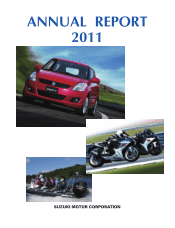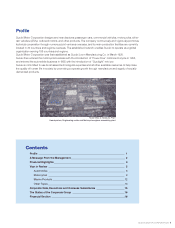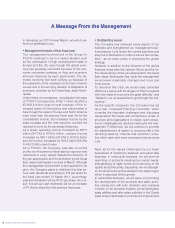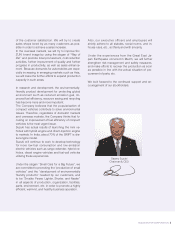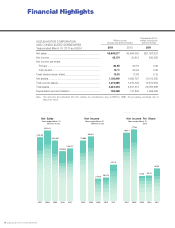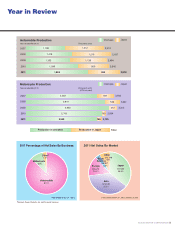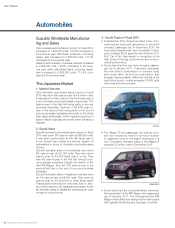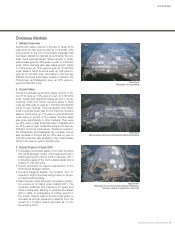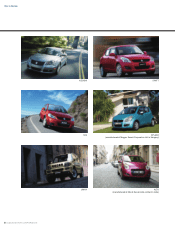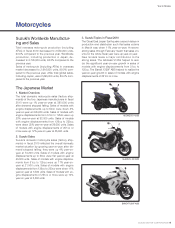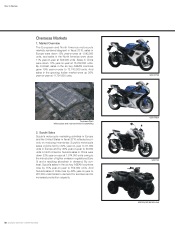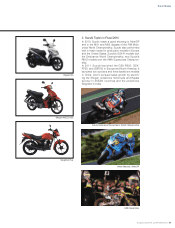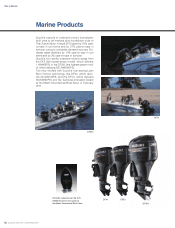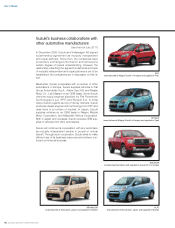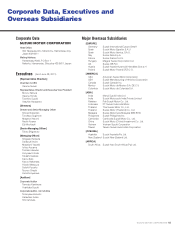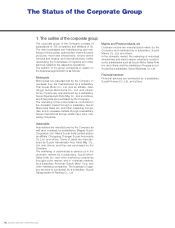Suzuki 2011 Annual Report Download - page 7
Download and view the complete annual report
Please find page 7 of the 2011 Suzuki annual report below. You can navigate through the pages in the report by either clicking on the pages listed below, or by using the keyword search tool below to find specific information within the annual report.
6 SUZUKI MOTOR CORPORATION
Suzuki’s Worldwide Manufactur-
ing and Sales
Total overseas automobile production for fiscal 2010
increased to 1,884,000 units, 118.8% compared to
the previous year. Worldwide production, including
Japan, also increased to 2,878,000 units, 113.1%
compared to the previous year.
Sales of automobiles in overseas markets increased
to 2,053,000 units, 118.8% compared to the previ-
ous year, while total global sales, including Japan,
also increased to 2,642,000 units, 112.4% com-
pared to the previous year.
The Japanese Market
1. Market Overview
Total domestic automobile sales volume in fiscal
2010 was down 6% year-on-year at 4.6 million units.
It was below 5 million units for the third fiscal year in
a row. Domestic automobile sales volume rose 17%
year-on-year in the first half owing partly to eco-car
purchase subsidies. However, it fell 24% year-on-
year in the second half owing partly to the end of
eco-car purchase subsidies and partly to the Great
East Japan Earthquake, which caused a big drop in
sales in March (typically the month when demand is
highest).
2. Suzuki Sales
Suzuki’s domestic automobile sales volume in fiscal
2010 was down 5% year-on-year at 588,000 units.
It was down year-on-year for the fifth fiscal year in
a row. Suzuki was number four among Japan’s 12
automakers in terms of domestic automobile sales
volume.
Suzuki’s domestic sales of minivehicles were down
6% year-on-year at 521,000 units. They were down
year-on-year for the fifth fiscal year in a row. They
rose 9% year-on-year in the first half owing to eco-
car purchase subsidies. Despite the launch of the
new MR Wagon, they fell 19% year-on-year in the
second half due to the end of eco-car purchase
subsidies.
Suzuki’s domestic sales of registered vehicles were
up 1% year-on-year at 68,000 units. They were up
year-on-year for the first time in three fiscal years.
Thanks partly to the launch of the new Solio in Janu-
ary, Suzuki was the only Japanese automaker to see
its domestic sales of registered vehicles grow year-
on-year in volume terms.
Automobiles
3. Suzuki Topics in Fiscal 2010
• InSeptember2010,Suzukilaunchedanew,com-
prehensively improved generation of the Swift
compact passenger car. In November 2010, the
Automotive Researchers’ and Journalists’ Confer-
ence of Japan (RJC) gave the new Swift the 2011
RJC Car of the Year award in recognition of its
high levels of driving performance and environ-
mental performance.
• SuzukilaunchedthenewSoliocompactpassen-
ger car in January 2011. Customers welcomed
the new Solio’s combination of compact body
and roomy cabin, its low fuel consumption, and
its great manoeuvrability. Within two months of the
new Solio’s launch, orders exceeded 10,000 units
(five times Suzuki’s forecast).
WAGON R
SOLIO
• The Wagon R mini passenger car was the num-
ber-one minivehicle model in terms of number
of registered units for the eighth fiscal year in a
row. Cumulative domestic sales of the Wagon R
reached 3.5 million units in December 2010.
Year in Review
• Suzuki launched the comprehensively improved,
third generation of the MR Wagon mini passenger
car in January 2011. The third-generation MR
Wagon has a distinctive design and a new engine
that highlight its identity as a new type of vehicle.

